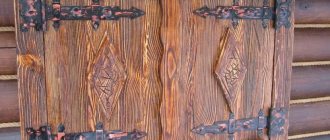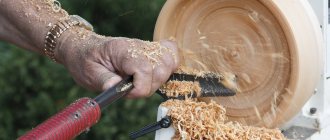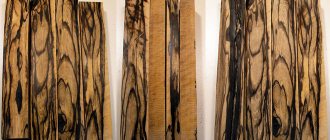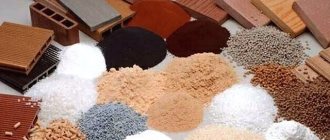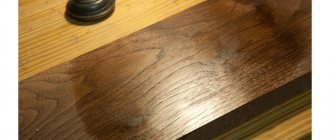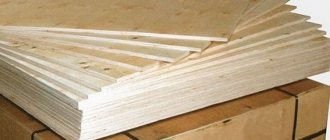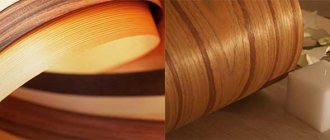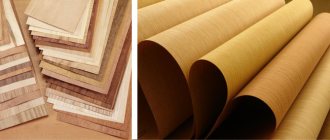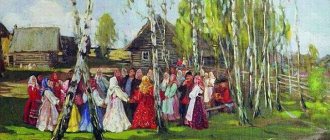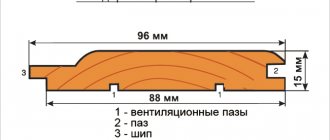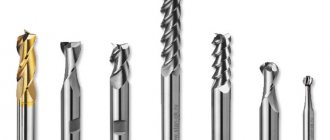Forget about fancy finishing. Use these four methods to identify different characteristics of red oak.
Beautiful finishing does not always require sophisticated technology. Sometimes you can give a product the desired look with just a couple of simple steps. To demonstrate the capabilities of four simple finishes, we tested them on small oak tables, keeping in mind the following basic rules for applying finishes.
|
Impregnation using parquet varnishes
All compounds in this group, without exception, are extremely toxic, which must be taken into account when choosing this method of impregnating wood. Treatment should be carried out in well-ventilated areas, at air temperatures up to 25°C (at higher temperatures, varnishes begin to evaporate even more intensely), and also with the use of personal protective equipment: safety glasses and a gauze bandage (or a respirator).
The toxicity of board impregnation varnishes depends on the type of solvent. Varnishes are made on a water basis and on the basis of synthetic solvents. Water-based varnishes are much less toxic, although they dry somewhat slower. However, in this case, this is not a disadvantage, but rather an advantage of the composition: quick-drying impregnating varnishes are very demanding on the quality of their application, and with insufficient experience of the performer, they leave behind clearly defined streaks. They can only be eliminated by re-varnishing the wood, and this leads to increased consumption of varnish and prolongation of work.
A clear advantage of parquet varnishes is their durability. Oak treated with such compounds will subsequently require only cosmetic maintenance of cleanliness and texture, which can be achieved by applying polish of the required color to the surface of the floorboard. Sometimes stains are successfully used to maintain the external texture of oak coverings.
How to maintain the attractiveness of the finish?
By following these simple instructions, your cutting board will retain its visual appeal for many years.
- After use, wash the product well with warm water, using minimal detergent if possible. Wipe off excess moisture without special zeal and do not allow the board to remain in water for a long time.
- The finishing of the kitchen board needs periodic updating. The outer layer is “refreshed” as it wears out, usually once every 4-5 months, depending on the intensity of use of the product. By controlling the condition of the protective layer, you will protect the board from cracking, swelling, and mold formation, while maintaining its visual appeal.
- When the working side of the board is severely damaged by knives, it is sanded and the finish is reapplied.
Impregnation using oil-wax compounds
This impregnation technology is much “cleaner” from an environmental point of view, since it uses non-toxic components of natural origin.
Oil-wax mixtures are used not only for impregnation, but also for restoration of damaged areas of the board. Advantages of this impregnation method:
- Giving the coating antistatic characteristics. Due to treatment with oil compounds, the risk of accumulation of static electricity on the surface of oak parquet boards is reduced. When treated with varnishes, an antistatic effect does not occur, which is explained by the polarization of the organic solvent during its application to the surface of the wood.
- The oil-wax surface is warmer to the touch, which is explained by the increased heat capacity of the impregnation components. Therefore, the treated rooms will be warmer in winter.
- The relatively low volatility of the oil allows it to penetrate into the internal structure of the oak board to a considerable depth. As a result, wood porosity decreases and density increases.
- The presence of wax gives the impregnating composition the ability to cover minor surface defects in wood that can arise, for example, from the claws of pets.
- Wax itself is a water-repellent composition, so the board will not suffer from excess moisture, for example, when washing floors.
- Wax-oil impregnations can be used to treat any room in the house. Most often they process boards made of oak, ash, and larch.
Processing oak at home - Metals, equipment, instructions
Impregnation of wood is a necessary operation that extends their service life. It must be carried out even if oak and other species are processed appropriately for sale (for example, in terms of relative humidity). The reason is the unfavorable operating conditions of the floorboard: high operating loads, and frequently changing surface moisture of the wood.
Wood processing and finishing of wood products
Details Category: Wood and lumber: June 26, 2012 26038
Staining and varnishing when processing wood
Wood in its natural form does not always look attractive compared to surrounding objects and furniture. It turns gray when exposed to ultraviolet light. Wood that is not coated with any protective compound is very hygroscopic.
It begins to warp even from the difference in winter and summer air humidity. In this regard, wood processing is a necessary procedure to preserve the consumer qualities of wooden products.
The finished item has a more attractive appearance compared to the natural one.
You can process wood of any species from oak to birch. Although different types of trees look different after finishing. For example, the natural pattern of birch is quite uniform. It is devoid of contrasting transitions and annual rings around knots. Pine and spruce look beautiful, especially their “knot” parts. The natural pattern of chestnut, oak, and beech is considered the most attractive.
Before finishing, it is necessary to thoroughly sand the wooden part with sandpaper (sandpaper). Moreover, movements with the sandpaper should occur strictly in the direction of the fibers and without strong pressure. The resulting transverse risks after varnishing and staining will become easily visible.
Wood stain
To remove microscopic dust particles from the fibers, it is recommended to thoroughly vacuum the wood after sanding. After this, the part can be coated with stain. It can be non-aqueous and aquatic.
Water, as the name suggests, on the water. This type of stain is used quite rarely, mainly for staining small parts. Non-aqueous (solvent based) is used for any parts.
https://www.youtube.com/watch?v=GDmChHqhXUM
Non-aqueous stain dries and absorbs quickly and has a wide range of colors.
The treated wood is heavily impregnated with stain. Small parts are mostly stained, completely immersed in stain. When staining large items, use a regular brush. Wood stain should be applied in excess.
Features of the material
Manufacturers of oak parquet have strict requirements for the conditions of harvesting and storage of wood.
- The wood is of high quality and must be aged for at least 6 months.
- Each tree must be cut according to an individual pattern.
- During six-month storage, wood must undergo a natural drying process at special sites under the strict supervision of specialists.
- Wood received at the plant is evaporated in a drying chamber.
- The material must be subjected to secondary drying, which completes the process of preparing the raw material, finally stabilizing the wood.
All requirements for the raw materials from which oak parquet is made make it resistant to changes in temperature and humidity, guarantee strength and durability, and increase wear resistance. The finished material goes through the stage of selective sorting and packaging in polyethylene or cardboard, which ensures that the linear dimensions of the wood are preserved during transportation.
The quality and color of the wood directly depend on where the oak grows. A tree grown in a dry, sandy area will have a yellowish tint, a fine-grained texture, high hardness, and a low elasticity index. Oak, cut in the mountains, has large layers of wood that have a pale pink tint.
Turning a cutting board into an eye-catching decor
Inspired by the ideas in our gallery, you can create a product that will turn from ordinary household utensils into original decor for your kitchen. Such an expressive and functional piece of furniture will be a spectacular gift that no housewife will remain indifferent to.
Oak is a very popular material that is widely used:
- Construction.
- Finishing work.
- Making furniture.
- Making art objects and souvenirs.
Naturally, not only freshly felled and sawn wood is used, but processed and high-quality dried material. This is a prerequisite to avoid future cracking, changing the shape and size of the product. Oak, which is used in construction or furniture making, must have certain physical and mechanical properties.
Therefore, when sawing is completed, the question arises: “ How to properly dry oak
" We will answer this in this article.
Drying oak at home - technology to prevent it from cracking
Wooden products made from oak belong to the premium class. The wood is used to make furniture and interior parts. Oak is rarely used for construction, as the price of the material is high. In order for the wood to last longer and not crack over time, it must be properly processed. One of the critical stages of processing is drying. Let's talk about how to dry oak at home and in production in more detail with our readers.
Several available methods for preparing wood
For home processing, the following methods are used:
- Dry the oak tree in advance. The required tree is marked in advance on the plot and in the spring the bark is removed from it, right from the roots to a height of 20–30 cm. The juices will not be able to reach the crown in the required volume and the oak will dry out. In the fall it is cut down and cut into timber.
- Natural drying. Oak wood of natural moisture content is purchased. The material is laid out under cover on the site, so that the wood is blown from all sides. The material is laid on chocks in layers. The distance from the ground to the bottom row is at least 300 mm. Drying time is 3–6 months, depending on climate and humidity.
- Drying small items indoors. The oak product is wrapped in newspaper in 5–8 layers and covered with PVC film on top. Holes are made in the film for ventilation. The product is placed on the windowsill above the battery. Once an hour the package is turned over. The process takes 2–3 days. This is the most affordable way to dry a wooden product at home.
Drying large oak timber at home is difficult. The most affordable option is outdoors. But wood is hygroscopic and easily absorbs moisture from the air. That is, if drying is carried out during the rainy season, the process becomes useless. The easiest option is to harvest wood from the winter forest. In winter, at temperatures below -20, oak wood acquires moisture equivalent to chamber drying. Therefore, products from winter forest do not require additional preparation.
Methods in production
When preparing wood in production, chamber drying is used. The oak is placed in a special sealed convection chamber. Under the influence of high temperatures and ventilation, excess moisture gradually evaporates and the wood dries. The process is carried out in three stages:
- Wood heating.
- Drying.
- The oak cools and acquires the desired humidity.
The camera is constantly monitored, because if the process is disrupted or a mistake is made, the product begins to twist or crack. The kiln drying process lasts from 1 to 3 weeks. But many manufacturers shorten the process and the wood does not dry out completely.
It is important to check the moisture content of the wood from the inside before purchasing. For this, a manual moisture meter is used.
The vacuum drying method is carried out in special chambers, where, under the influence of atmospheric pressure and high temperatures, the minimum moisture content of lumber is achieved. The vacuum method is used in production for preserving wood, since in the chambers the product is additionally treated with antiseptics. The compounds penetrate deep into the wood under the influence of vacuum. This increases shelf life and improves product quality during transportation. The vacuum method is difficult to reproduce at home, as special equipment is required.
Chamber drying, due to its high cost, is gradually fading into the background. A new method is replacing it - infrared preparation. Infrared treatment reduces drying time and saves electricity. At the same time, the effect on oak wood is uniform and soft, and does not destroy the product from the inside and outside. Exposure to infrared heat makes it possible to obtain any percentage of humidity.
